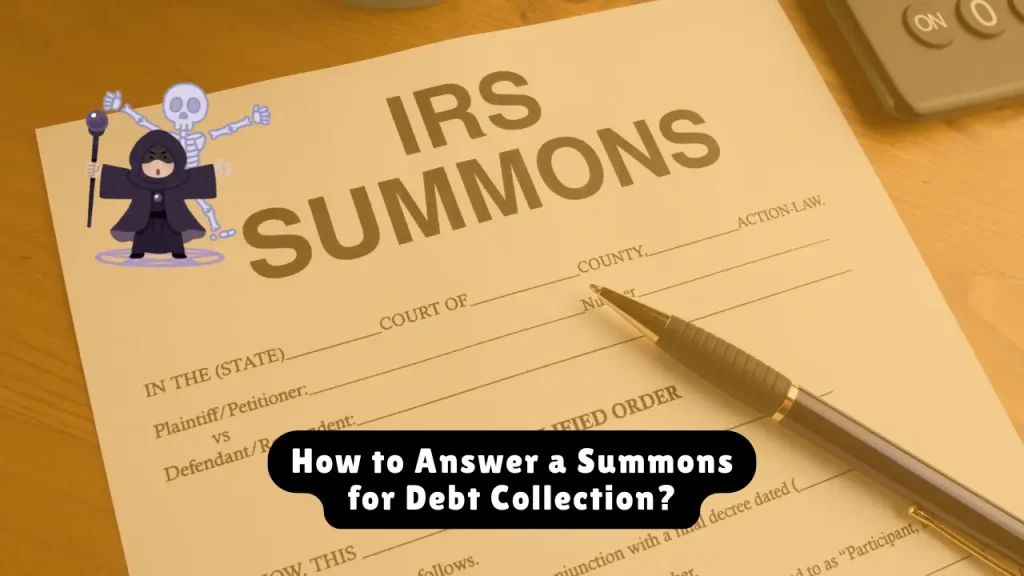How to Answer a Summons for Debt Collection?
If you’ve been served with a debt collection summons, your response could determine whether you face wage garnishment, a court judgment, or complete dismissal. Here’s a step-by-step breakdown of how to respond effectively, assert your rights, and avoid default—no lawyer required.
What Is a Summons for Debt Collection?
A summons is a legal notice that you’re being sued for an unpaid debt. It typically includes a complaint, which outlines the creditor’s allegations—including the amount owed, who’s suing you, and the legal basis for the claim.
If you don’t respond in time, the court may issue a default judgment—allowing wage garnishment, bank levies, or even property liens.
Table of Contents
Step 1: Check Your Deadline to Respond
Your time to answer varies by state and how you were served:
| Type of Service | Typical Deadline |
| Personal (hand-delivered) | 20–30 days |
| Substituted or mail | 30–40 days |
| Example: Texas | 14–30 days (varies by court) |
| Example: California | 30 days (use Form PLD-C-010) |
Tip: Mark your calendar the day you receive the summons. If the deadline falls on a weekend or holiday, your response is due the next business day.
Step 2: Review the Summons & Complaint
Before drafting your response, analyze the documents carefully:
- Verify the creditor’s name and licensing (especially in NY, CA—debt buyers must include license numbers).
- Confirm details: debt amount, original creditor, case number, and court location.
- Look for errors: 60% of sold debts contain inaccuracies. Dispute if:
- The debt isn’t yours.
- Amount includes inflated or illegal fees.
- The statute of limitations has expired (typically 3–6 years for credit cards).
- The debt isn’t yours.
Step 3: Draft Your Answer — Line-by-Line
Your Answer must address every allegation in the complaint using one of three responses:
- Admit – if the claim is accurate.
- Deny – to force the creditor to prove it.
- Lack knowledge – if you’re unsure, which still requires proof.
Example Answer format:
yaml
CopyEdit
Defendant’s Answer:
Paragraph 1: Deny.
Paragraph 2: Defendant lacks knowledge sufficient to admit or deny.
Include:
- Court name, case number, plaintiff and defendant names
- Signature (notarized if your state requires it)
- Certificate of Service proving you mailed a copy to the plaintiff or their attorney
Related article: How to Respond to a Debt Collection Summons in California?

Step 4: Assert Affirmative Defenses
These are legal reasons the lawsuit should be dismissed. If not included in your initial Answer, they’re usually waived permanently.
| Defense | When to Use | Evidence Required |
| Statute of limitations | Debt is too old (check state limits) | Last payment date, account records |
| Improper service | You weren’t served legally | Lack of personal delivery, proof of address |
| Identity theft | You didn’t open the account | Police report, FTC affidavit |
| Debt paid or settled | You already paid or settled the balance | Receipts, bank statements |
| No standing to sue | Debt buyer can’t prove they own the debt | Demand assignment records |
| Protected income | They’re trying to seize exempt funds (e.g., SSI) | Proof of income source |
New York Note: If the complaint doesn’t include the debt collector’s license number, you can move to dismiss the case.
Step 5: File & Serve the Answer
File with the Court:
- Submit the original to the court clerk (by mail, e-filing, or in person).
- Pay the filing fee (ranges $0–$450). Request a fee waiver if you qualify.
- Sign and date your Answer.
Serve the Plaintiff:
- Send a copy of the Answer to the creditor’s attorney.
- Use certified mail with return receipt.
- Attach a Certificate of Service as proof.
Step 6: Common Mistakes to Avoid
- Ignoring the summons: Over 80% of debt lawsuits end in default judgments because people don’t respond.
- Admitting partial guilt: Even saying “I’ll pay later” could reset the statute of limitations.
- Unwritten settlements: Get all negotiations in writing to avoid future disputes.
Step 7: What Happens After You File?
Once your Answer is submitted:
- The court may schedule a hearing or pretrial conference.
- The creditor might offer to settle—sometimes for 30–60% of the original balance.
- You can negotiate or request debt validation (especially if documents like contracts or payment history are missing).
- Consider bankruptcy as a last resort—it triggers an automatic stay and wipes eligible debts within 3–4 months.
Step 8: Missed the Deadline?
If a default judgment has already been entered:
- You can file a Motion to Vacate Judgment if you have valid reasons (e.g., medical emergency, improper service).
- Courts may still accept late Answers in some cases—ask your local clerk for guidance.
FAQs
Do I need a lawyer?
No, but legal aid is available. You can also use tools like SoloSuit ($99–$199) to draft a legally sound response.
Can I counter-sue?
Yes—especially if the debt collector violated the Fair Debt Collection Practices Act (FDCPA). Include your counterclaim in your Answer.
What if I can’t afford to pay anything?
Assert defenses like protected income or file for a fee waiver. Filing the Answer still blocks a default judgment.
When to Consult a Lawyer
Seek legal assistance if:
- The debt is over $10,000
- You’re facing complex issues (identity theft, property seizure)
- The collector violated your consumer rights (FDCPA violations can entitle you to damages + legal fees)
Final Takeaway: Respond = Regain Control
Debt collectors win 80% of lawsuits by default—not by evidence. Filing an Answer flips the script.
“Your response alone shifts the odds in your favor.” — Upsolve Legal Team
Resources & Tools
- SoloSuit.com – Draft and file your Answer in minutes
- National Consumer Law Center – Free legal guides and defense strategies
- State Court Portals – Download official Answer forms by state
About the Author

Sarah Klein, JD, is a former consumer rights attorney who spent years helping clients with issues like unfair billing, product disputes, and debt collection practices. At All About Lawyer, she simplifies consumer protection laws so readers can defend their rights and resolve problems with confidence.
Read more about Sarah
